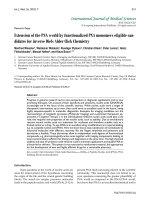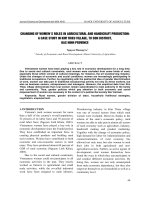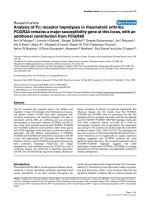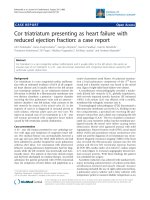Báo cáo y học: "Compression of the median nerve in the proximal forearm by a giant lipoma: A case report" docx
Bạn đang xem bản rút gọn của tài liệu. Xem và tải ngay bản đầy đủ của tài liệu tại đây (1.67 MB, 4 trang )
BioMed Central
Page 1 of 4
(page number not for citation purposes)
Journal of Brachial Plexus and
Peripheral Nerve Injury
Open Access
Case report
Compression of the median nerve in the proximal forearm by a
giant lipoma: A case report
Sebastian E Valbuena*
1
, Greg A O'Toole
2
and Eric Roulot
2
Address:
1
Deparment of Orthopeadic Surgery & Traumatology, Hospital Interzonal El Cruce, Alta complejidad en red. Florencio Varela, Buenos
Aires, Argentina and
2
Institut de la Main, Clinique Jouvenet, Paris, France
Email: Sebastian E Valbuena* - ; Greg A O'Toole - ; Eric Roulot -
* Corresponding author
Abstract
Background: Compression of the median nerve by a tumour in the elbow and forearm region is
rare. We present a case of neuropathy of the median nerve secondary to compression by giant
lipoma in the proximal forearm.
Case presentation: A 46-year-old man presented with a six month history of gradually
worsening numbness and paresthesia on the palmar aspect of the left thumb and thenar eminence.
Clinical examination reveals a hypoaesthesia in the median nerve area of the left index and thumb
compared to the contralateral side. Electromyography showed prolonged sensory latency in the
distribution of the median nerve corresponding to compression in the region of the pronator teres
(pronator syndrome). Radiological investigations were initially reported as normal. Conservative
treatment for one month did not result in any improvement. Surgical exploration was performed
and a large intermuscular lipoma enveloped the median nerve was found. A complete excision of
the tumour was performed. Postoperative revaluation the X-ray of the elbow was seen to
demonstrate a well-circumscribed mass in the anterior aspect of the proximal forearm. At follow-
up, 14 months after surgery, the patient noted complete return of the sensation and resolution of
the paresthesia.
Conclusion: In case of atypical findings or non frequent localization of nerve compression,
clinically interpreted as an idiopathic compression, it is recommended to make a pre-operative
complementary Ultrasound or MRI study.
Background
Compression of the median nerve in the elbow and prox-
imal forearm region is much less frequent than within the
carpal tunnel [1]. Proximal compression is most com-
monly the result of anatomic variations with the supra-
condylar process and Struthers ligament [2], the lacertus
fibrosus (bicipital aponeurosis), the pronator teres muscle
and the arch of the flexor superficialis most commonly
implicated [3]. With less frequency, anomalous anatomic
structures are implicated in compression of the median
nerve, these being most commonly, the accessory head of
the flexor pollicis longus (Ganzer's muscle) [4], and a per-
sistent median artery [5].
Rarer causes of extrinsic compression of the median nerve
such as chronic compartment syndrome [6], partial rup-
Published: 10 June 2008
Journal of Brachial Plexus and Peripheral Nerve Injury 2008, 3:17 doi:10.1186/1749-7221-3-
17
Received: 21 February 2008
Accepted: 10 June 2008
This article is available from: />© 2008 Valbuena et al; licensee BioMed Central Ltd.
This is an Open Access article distributed under the terms of the Creative Commons Attribution License ( />),
which permits unrestricted use, distribution, and reproduction in any medium, provided the original work is properly cited.
Journal of Brachial Plexus and Peripheral Nerve Injury 2008, 3:17 />Page 2 of 4
(page number not for citation purposes)
ture of the distal biceps insertion [7], and synovial osteo-
chondromatosis at the elbow [8] have also been reported.
The compressive neuropathy of the median nerve second-
ary to lipoma is not frequent, and has been described
principally in the wrist and the hand [9-12]. We present a
case of compression of the median nerve in the proximal
forearm by a giant lipoma.
Case presentation
A 46-year-old man presented with a six month history of
gradually worsening numbness and paresthesia on the
palmar aspect of the left thumb and thenar eminence.
Static two point discrimination in the median nerve distri-
bution of the index and thumb showed a hypoaesthesia
compared to the contralateral side. Tinel's sign of the wrist
and forearm and Phalen's sign were negative. Active fore-
arm pronation against resistance in slight flexion, resisted
active forearm supination and resisted active index and
middle finger flexion did not elicit pain. Grip strength was
equal bilaterally. No masses were detectable on examina-
tion of the hand, wrist and forearm. No history of vacci-
nation, viral infection or medication within the previous
year was offered.
X-rays of the cervical vertebrae, elbow, forearm and hand
were initially reported as normal. However, on postoper-
ative revaluation the X-ray of the elbow was seen to dem-
onstrate a well-circumscribed mass in the anterior aspect
of the proximal forearm (Figure 1). Electromyography
showed prolonged sensory latency in the distribution of
the median nerve corresponding to compression in the
region of the pronator teres (pronator syndrome).
Conservative treatment (anti-inflammatory medication
and a diurnal long-arm splint) for one month did not
result in any improvement. Surgical exploration was
therefore performed under regional anesthesia and hemo-
static tourniquet. The surgical incision began just medial
to the biceps tendon and distal to the elbow flexion crease
and continued to the mid-forearm between the flexor and
extensor muscle masses. The medial antebrachial cutane-
ous nerve was identified and retracted. The pronator mass
and the biceps tendon were identified. An intermuscular
mass of adipose tissue was identified just lateral to the
superficial head of the pronator teres, the dissection was
not difficult but the median nerve was enveloped by the
tumour (Figure 2). Microsurgical techniques were used to
allow an extracapsular and non-traumatic dissection. A
complete excision of the tumour of 8 cm × 6 cm × 3 cm
was performed (Figure 4). The median nerve had an hour-
glass deformity as a result- of its compression (Figure 3).
Histopathological examination of the tissue removed at
surgery confirmed the presence of well-differentiated
mature fat cells (lipoma). There were no neural or neo-
plastic features.
At follow-up, 14 months after surgery, the patient noted
complete return of the sensation and resolution of the
paresthesia.
Intraoperative photo showing the median nerve within the intermuscular lipomaFigure 2
Intraoperative photo showing the median nerve within the
intermuscular lipoma.
A lateral elbow X-ray subtly demonstrates a well circum-scribed mass in the anterior proximal forearm (arrows)Figure 1
A lateral elbow X-ray subtly demonstrates a well circum-
scribed mass in the anterior proximal forearm (arrows).
Journal of Brachial Plexus and Peripheral Nerve Injury 2008, 3:17 />Page 3 of 4
(page number not for citation purposes)
Discussion
Lipomas are benign tumours originating from adipose
cells occurring in subcutaneous tissues, intermuscular,
intramuscular or paraosteal localizations [9]. Lipomas of
more than 5 cm diameter (Giant lipoma) are infrequent
in the upper limb [10]. In this anatomic location, masses
are generally symptomatic at a smaller size.
Nerve compression by a lipoma is uncommon [9,13] but
subfascial lipomas are deep tumours and can be a cause of
nerve compression [14].
Review of English literature on extrinsic nerve compres-
sion by lipoma in the upper limb reveals several reports of
compression of the radial nerve (especially the posterior
interosseous nerve due to the anatomic relation with the
neck of the radius) [8,15-19], and a few cases of ulnar
nerve compression in the forearm [11] and the Guyon's
canal [20-22]. The involvement of the median nerve was
also reported in the brachial plexus area's [23] and partic-
ularly in the wrist or the palmar region's [9-12,24-27].
Only one case documented an extrinsic compression of
the medial nerve in the proximal forearm by a giant
lipoma resulting in an anterior interosseous syndrome
[28]. To our knowledge, the case presented is the second
reported case of compression of the median nerve in the
proximal forearm by a giant lipoma.
Cribb et al. [10] documented a series of 10 giant lipoma-
tous tumours (7 lipomas, one neural fibrolipoma and two
well differentiated lipoma-like liposarcomas), five cases
were in the hand and five cases in the forearm, with signs
of median nerve compression in two cases, one in the
hand with the location of compression in the second case
being unclear. However, in all cases neurovascular struc-
tures required mobilisation in order to excise the tumour.
Cribb et al. [10] stressed the importance of a multidiscipli-
nary approach to investigations of giant soft tissue
tumours and suggested that an MRI should be routine. In
cases where an MRI does not clearly demonstrate a lipoma
or in those patients who could not tolerate the investiga-
tion, they go on to suggest that a biopsy be performed.
Johnson et al. [29] demonstrated that soft tissue masses of
greater than five cm in diameter should be considerate
malignant unless proven otherwise.
Marginal resection with conservation of the neurovascular
structures is the procedure of choice for lipomas, and a
more aggressive surgery is required in case of malign
tumour. In our case the diagnosis of tumour compression,
despite of the size of the lipoma, was made intra-opera-
tively as we had considered the atypical clinical findings
to be the result of idiopathic compression of the median
nerve in the elbow region.
Ultrasound is an excellent diagnostic study, especially for
deeply sited masses and can be used such cases. MRI how-
ever, provides more information of tumour type and of
Surgical area after lipoma excision: the arrow shows the hourglass deformation of the nerve at the level of the com-pressionFigure 3
Surgical area after lipoma excision: the arrow shows the
hourglass deformation of the nerve at the level of the com-
pression.
The giant lipoma was excised completely and measured 8 cm × 6 cm × 3 cmFigure 4
The giant lipoma was excised completely and measured 8 cm
× 6 cm × 3 cm.
Publish with BioMed Central and every
scientist can read your work free of charge
"BioMed Central will be the most significant development for
disseminating the results of biomedical research in our lifetime."
Sir Paul Nurse, Cancer Research UK
Your research papers will be:
available free of charge to the entire biomedical community
peer reviewed and published immediately upon acceptance
cited in PubMed and archived on PubMed Central
yours — you keep the copyright
Submit your manuscript here:
/>BioMedcentral
Journal of Brachial Plexus and Peripheral Nerve Injury 2008, 3:17 />Page 4 of 4
(page number not for citation purposes)
anatomic relations and is therefore preferable for diagnos-
tic precision and pre-operative planning.
Conclusion
Extrinsic median nerve compression by a tumour is rare.
However, in case of atypical findings or non frequent
localization of nerve compression, clinically interpreted
as an idiopathic compression, it is recommended to make
a pre-operative complementary Ultrasound or MRI study.
Competing interests
The authors declare that they have no competing interests.
Authors' contributions
SEV, GAO, and ER conceived the case report and inter-
preted the data, SEV performed all pertinent literature
review on the subject and drafted the manuscript, ER per-
formed the patient's surgery and collected the clinical
data, SEV assisted to ER in the surgery, GAO helped to
draft the manuscript.
All authors read and approved the final manuscrit.
Acknowledgements
No financial support was provided in any form to the authors of this man-
uscript.
References
1. Gross PT, Jones HR Jr: Proximal median neuropathies: electro-
myographic and clinical correlation. Muscle Nerve 1992,
15:390-395.
2. al-Qattan MM, Husband JB: Median nerve compression by the
supracondylar process: a case report. J Hand Surg [Br] 1991,
16(1):101-103.
3. Johnson RK, Spinner M, Shrewsbury MM: Median nerve entrap-
ment syndrome in the proximal forearm. J Hand Surg [Am]
1979, 4:48-51.
4. Dellon AL, Mackinnon SE: Musculoaponeurotic variations along
the course of the median nerve in the proximal forearm. J
Hand Surg [Br] 1987, 12(3):359-363.
5. Jones NF, Ming NL: Persistent median artery as a cause of pro-
nator syndrome. J Hand Surg [Am] 1988, 13:728-32.
6. Kutz JE, Singer R, Lindsay M: Chronic exertional compartment
syndrome of the forearm: a case report. J Hand Surg [Am]
1985, 10(2):302-304.
7. Foxworthy M, Kinninmonth AW: Median nerve compression in
the proximal forearm as a complication of partial rupture of
the distal biceps brachii tendon. J Hand Surg [Br] 1992,
17:515-517.
8. Nogueira A, Alcelay O, Pena C, Sarasua JG, Madrigal B: Synovial
osteochondromatosis at the elbow producing ulnar and
median nerve palsy. Case report and review of the litera-
ture. Chir Main 1999, 18:108-114.
9. Leffert RD: Lipoma of the upper extremity. J Bone Joint Surg Am
1972, 54:1262-1266.
10. Cribb GL, Cool WP, Ford DJ, Mangham DC: Giant lipomatous
tumors of the hand and forearm. J Hand Surg [Br] 2005,
30(5):509-512.
11. Flores LP, Carneiro JZ: Peripheral nerve compression second-
ary to adjacent lipomas. Surg Neurol 2007, 67:258-263.
12. Babins DM, Lubahn JD: Palmar lipomas associated with com-
pression of the median nerve. J Bone Joint Surg Am 1994,
76(9):
1360-1362.
13. Phalen GS, Kendrick JI, Rodriguez JM: Lipomas of the upper
extremity. A series of fifteen tumours in the hand and six
tumours causing nerve compression. Am J Surg 1971,
121:298-306.
14. Barber KW, Bianco AJ Jr, Soule ED, McCarty CS: Benign extraneu-
ral soft tissues tumours of the extremities causing compres-
sion of nerves. J Bone Joint Surg Am 1962, 44:98-104.
15. Bieber EJ, Moore JR, Weiland AJ: Lipomas compressing the
radial nerve at the elbow. J Hand Surg [Am] 1986, 11(4):533-535.
16. Fitzgerald A, Anderson W, Hooper G: Posterior interosseous
nerve palsy due to parosteal lipoma. J Hand Surg [Br] 2002,
27:535-537.
17. Lidor C, Lotem M, Hallel T: Parosteal lipoma of the proximal
radius: a report of 5 cases. J Hand Surg [Am] 1992, 17:1095-1097.
18. Nishida J, Shimamura T, Ehara S, Shiraishi H, Sato T, Abe M: Poste-
rior interosseous nerve palsy caused by parosteal lipoma of
proximal radius. Skeletal Radiol 1998, 27:375-379.
19. Werner CO: Radial nerve paralysis and tumor. Clin Orthop Relat
Res 1991, 268:223-225.
20. Bui-Mansfield LT, Williamson M, Wheeler DT, Johnstone F: Guyon's
canal lipoma causing ulnar neuropathy. AJR Am J Roentgenol
2002, 178:1458.
21. Galeano M, Colonna M, Risitano G: Ulnar tunnel syndrome sec-
ondary to lipoma of the hypothenar region. Ann Plast Surg
2001, 46:83-84.
22. Zahrawi F: Acute compression ulnar neuropathy at Guyon's
canal resulting from lipoma. J Hand Surg [Am] 1984,
9(2):238-240.
23. Weinzweig N, Browne EZ Jr: Infraclavicular median nerve com-
pression caused by a lipoma. Orthopedics 1988, 11:1077-1078.
24. Oster LH, Blair WF, Steyers CM: Large lipomas in the deep pal-
mar space. J Hand Surg [Am]
1989, 14(4):700-704.
25. Schmitz RL, Keeley JL: Lipomas of the hand. Surgery 1957,
42:696-700.
26. Sonoda H, Takasita M, Taira H, Higashi T, Tsumura H: Carpal tun-
nel syndrome and trigger wrist caused by a lipoma arising
from flexor tenosynovium: a case report. J Hand Surg [Am]
2002, 27(6):1056-1558.
27. Kremchek TE, Kremchek EJ: Carpal tunnel syndrome caused by
flexor tendon sheath lipoma. Orthop Rev 1988, 17:1083-1085.
28. Higgs PH, Young VL, Schuster R, Weeks PM: Giant lipomas of the
hand and forearm. South Med J 1993, 86:887-890.
29. Johnson CJ, Pynsent PB, Grimer RJ: Clinical features of soft tissue
sarcomas. Ann R Coll Surg Engl 2001, 83:203-205.









